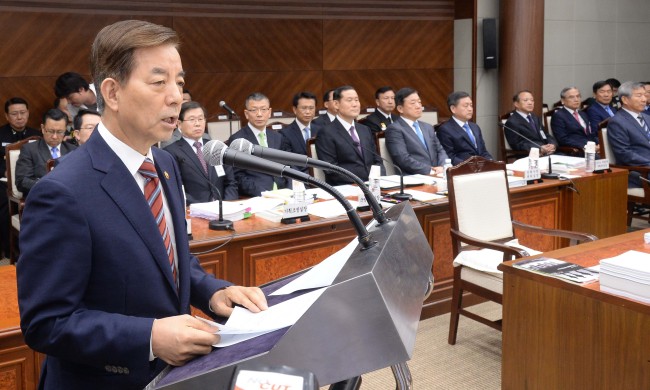Seoul’s Defense Minister Han Min-koo on Tuesday offered a positive view of Washington’s possible deployment of an advanced missile defense asset to the peninsula, saying it would contribute greatly to the defense of South Korea.
During a parliamentary audit in the ministry building in Seoul, Han said that he was looking at the deployment of the Terminal High-Altitude Area Defense system, a key element of the global U.S. missile defense program, “from a standpoint of national security.”
“While the assets that are available to cope with the North’s nuclear and missile threats are limited, the deployment of the THAAD would help ensure South Korea’s security and defense,” he said during the audit.
 |
| Defense Minister Han Min-gu speaks during a parliamentary interpellation session in the ministry’s building in Seoul on Tuesday. (Lee Gil-dong/ The Korea Herald) |
“Given that the operational coverage of the THAAD is wide, should it be deployed here, it would help the defense of South Korea.”
Seoul has been reluctant to openly talk about the issue of the THAAD deployment as it could cause diplomatic friction with Beijing and Moscow, which believe that the deployment could potentially target them in case of a crisis.
The U.S. has conducted site surveys to see if it is feasible to deploy the THAAD to the peninsula. U.S. Forces Korea Commander Gen. Curtis Scaparrotti has said that Washington was considering the deployment to better deal with “evolving” missile threats from the North.
To better tackle Pyongyang’s ballistic missile threats, the allies have been working to create a new operational concept.
Under the concept, U.S. missile defense assets including high-tech radar and interception systems are expected to be mobilized. The allies may make public their plan to create the concept during their defense ministers’ Security Consultative Meeting in Washington later this month, a government source said.
“South Korea and the U.S. are developing comprehensive combined capabilities to deal with North Korea’s increasing missile threats. At the core of the efforts is creating the alliance’s operational anti-missile concept and principles,” said the source on condition of anonymity.
“After the concept and principles are established, the allies would work on developing them into an operational plan.”
Observers think that the antimissile concept will mobilize the U.S. Forces Korea’s monitoring and detection assets and the U.S. strategic missile defense assets that are placed outside the peninsula, but cover the security of the peninsula.
Core U.S. MD assets include the X-band radar with an operational range of longer than 1,000 kilometers, the Terminal High-Altitude Area Defense system, the high-altitude surveillance drone Global Hawks, and the Joint Surveillance Target Attack Radar System, the airborne battle management aircraft. The U.S. wants to bring in the THAAD and X-band radar to the peninsula.
Analysts said that the allies may have tried to forge the antimissile concept through simulations during their annual exercises such as the Key Resolve and Ulchi-Freedom Guardian, and through consultations at their Extended Deterrence Policy Committee.
The source noted that the development of the concept does not mean that South Korea would participate in the U.S. missile defense program. Seoul has remained reluctant to join the U.S. missile defense network as its participation could strain ties with China and Russia that believe the U.S. missile defense system could target them in case of a crisis.
The pursuit of the antimissile concept appears to be proceeding in line with the allies’ ongoing efforts to flesh out and more effectively apply their “tailored deterrence strategy.”
Last year, the allies’ defense ministers formally endorsed the strategy. The strategy is a set of concrete military and nonmilitary procedures to deal with threats from the North’s nuclear arms and other weapons of mass destruction.
The assets for the strategy include the U.S.’ full range of capabilities including its nuclear umbrella, and conventional strike and missile defense assets.
Meanwhile, the Defense Ministry claimed that the North planned to declare 2015 as a year to complete the “unification war” and was preparing for all-out war through tougher tactical exercises and bolstered military capabilities.
In its parliamentary policy briefing, the ministry also said the number of North Korean summertime drills doubled this year, and that the North has gradually increased its strike capabilities.
Over the last two years, the North has increased its number of multiple rocket launch systems by some 300. Currently the figure stands at 5,100, an increase from a 2012 estimate of 4,800, according to data from the ministry.
By Song Sang-ho (sshluck@heraldcorp.com)



